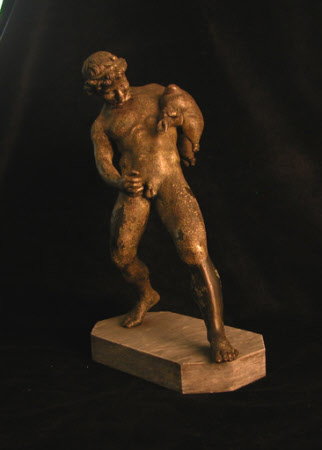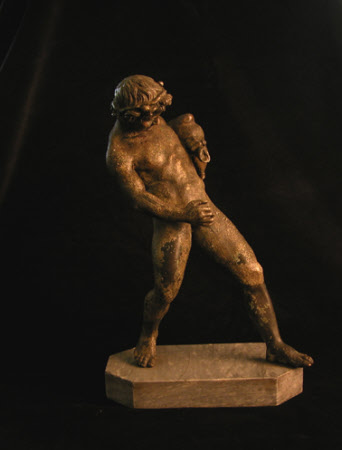Faun with a wineskin
probably Italian (Neapolitan) School
Category
Art / Sculpture
Date
Unknown
Materials
Bronze
Measurements
319 x 223 x 125 mm
Place of origin
Naples
Order this imageCollection
Anglesey Abbey, Cambridgeshire
NT 515107
Summary
Bronze, Faun with a wineskin, Italian (Neapolitan) School, probably the Chiurazzi Foundry, probably 20th century. A bronze fountain figure of a naked faun holding a wineskin in his left arm, leaning backwards and left leg forward. In the faun’s hair is a vine branch, without leaves. Right hand held by side, fingers curled to hold a wine cup, now missing, into which water would once have poured from the wineskin, simulating the pouring of wine. A thick greenish patination intended to emulate ancient bronze. Mounted on grey octagonal marble base. The figure is a modern reduction of a bronze fountain figure found in the House of the Century in Pompeii.
Full description
The Faun with a wineskin is one of the finest bronze figures to have been discovered at Pompeii. Today in the Museo Archeologico Nazionale in Naples (Inv. 111495, height 51 cm.; Stefano De Caro, ed., Il Museo Archeologico Nazionale di Napoli, Naples 1994, p. 206), the bronze figure was found in the House of the Centenary (Casa del Centenario, IX, 8, 3-6), discovered in 1879 and given its name to mark the 18th centenary of the eruption of Vesuvius in A.D. 1879, that buried Pompeii and Herculaneum. The fountain figure was found during the first excavations of the house in 1879. Datable to the late second or early first century B.C. and an excellent example of Hellenistic style, it was found standing on a small tufa base in the middle of the rounded part of the north edge of the house’s bathing pool. Water would originally have poured from the mouth of the wineskin into a cup that the satyr was holding in his right hand. The Anglesey Abbey copy is a reduction of the figure from Pompeii, just over half the size of the original. A not very distinguished reproduction, it was possibly made by the Neapolitan firm of Chiurazzi, although this firm generally marked its bronzes with the foundry stamp. Although members of the Chiurazzi were casting already in the eighteenth century, the firm’s fortunes began to grow when in 1870 it established a foundry. The Chiurazzi reached the peak of their success in the early decades of the twentieth century, when the foundries employed some six hundred workers engaged in the casting of original bronze works of art but, more importantly, the manufacture of copies of antiquities from Pompeii and elsewhere, in bronze and in marble and in ceramic. The illustration in the 1929 Chiurazzi catalogue appears to show the faun on the type of base on which the Anglesey Abbey figure is mounted, marble and with canted sides (Salvatore Chiurazzi, Chiurazzi. Fonderie, Ceramica, Marmeria, Naples 1929, p. 60, no. 89). The Chiurazzi price list from 1929 (p.37) indicates that the casts of the Faun could be bought in three sizes, 56, 30 and 24 cm., and, like most of the bronzes made by the Chiurazzi, the buyer could select from one of three patinations, Pompeii (green), Herculaneum (dark) and Renaissance (lustrous rich brown). If it was made by the Chiurazzi, the Anglesey Abbey figure must therefore be an example of the medium-sized cast, with a ‘Pompeii’ patination. Jeremy Warren 2020
Provenance
Bequeathed to the National Trust by Huttleston Rogers Broughton, 1st Lord Fairhaven (1896-1966) with the house and the rest of the contents.
Credit line
Anglesey Abbey, The Fairhaven Collection (The National Trust)
Makers and roles
probably Italian (Neapolitan) School, founder
References
Christie, Manson & Woods 1971: The National Trust, Anglesey Abbey, Cambridge. Inventory: Furniture, Textiles, Porcelain, Bronzes, Sculpture and Garden Ornaments’, 1971, p. 128.

